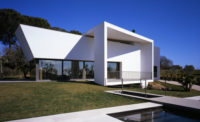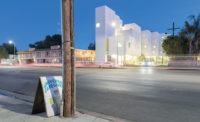Palm Springs, California
Program: Situated on a 4.5-acre plot, the 85,000-square-foot 57-unit affordable housing complex was commissioned by the Coachella Valley Housing Coalition, a nonprofit, low-income housing developer in southern California. The apartments range from one to four bedrooms (667 to 1,400 square feet) and offer a host of amenities, including a pool, basketball court, bike racks, 130 parking spaces, courtyards, and a 3,000-square-foot community center.
Design concept and solution: Built on the site of a vacant apartment building in the Palm Springs desert, the complex is certified as LEED Gold and minimizes energy consumption through building orientation, passive-solar design, and recycled materials. The low-slung one- and two-story units are insulated with recycled newspaper and have double-pane windows, fluorescent lighting, and dual-flush toilets. During construction, more than 80 percent of waste was recycled, and the complex is positioned to optimize wind ventilation and daylight.
Construction cost: $12.5 million
Completion date: 2011
Architect:
Brooks + Scarpa (formerly Pugh + Scarpa)
4611 W. Slauson Ave
Los Angeles, CA 90043
Tel. 310-828-0226
fax 310-453-9696
People
Owner:
Architect:
Project Team:
Landscape:
Engineering: Acoustics: Veneklasen Associates LEED: Ted Bardacke, Global Green General Contractor: Brown Construction Photography: John Edward Linden |
Products
Structural system:
Exterior
Interior finishes
Conveyance
Lighting
Plumbing
Energy
Data Sources & Reliability Green Strategies:
Solar Cooling Loads
Non-Solar Cooling Loads
Lighting Controls
Refrigerators
Materials & Resources Finishes were minimized throughout: Concrete slabs were left exposed where possible and the exterior stucco finish has an integral pigment in lieu of a paint finish. The exterior metal screen at front facade is aluminum with an anodized color and the side yard screen is 'galvalume' a galvanized finish- neither screen will require painting or finishing in the future.
Diversion of Construction & Demolition Waste
Green Products Used Green Strategies:
Protection of Global Ecosystem
Design for Materials Use Reduction
Job Site Recycling
Recycling by Occupants
Greenhouse Gas Emissions from Manufacture
Resource-Efficient and Materials
Transportation of Materials
Indoor Environment
Environmental air quality was addressed by following AQMD (Southcoast Air Quality Mangement District) and Greenseal requirements for finishes and by minimizing finishes: concrete slabs were left exposed where possible and an integral color was provided in the exterior stucco finish, thereby eliminating the need for painting of the exterior of the building.
Thermal Comfort
Visual Comfort and Light Sources
|








Post a comment to this article
Report Abusive Comment